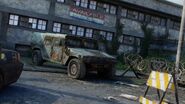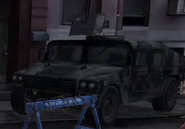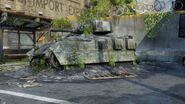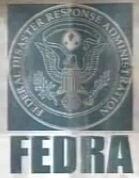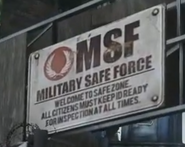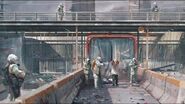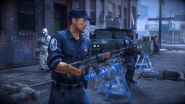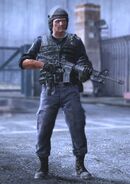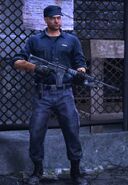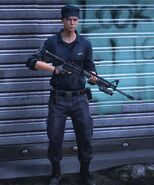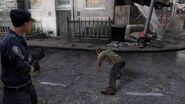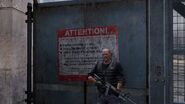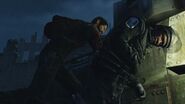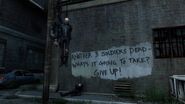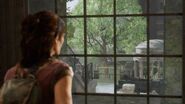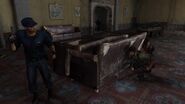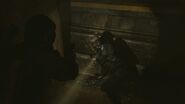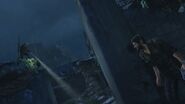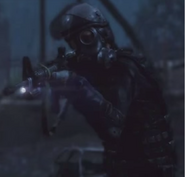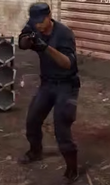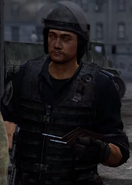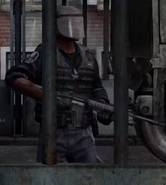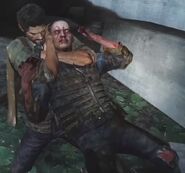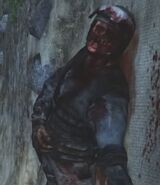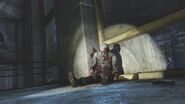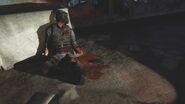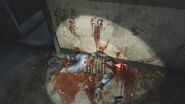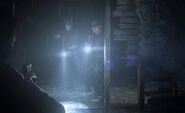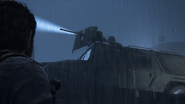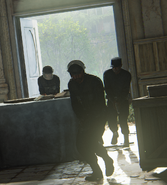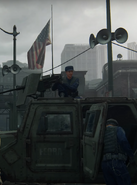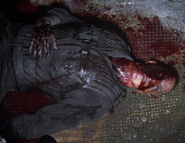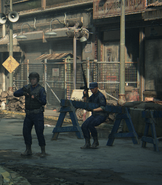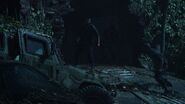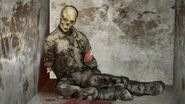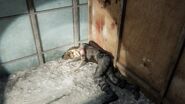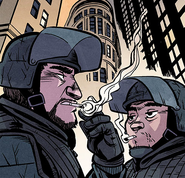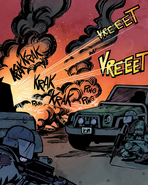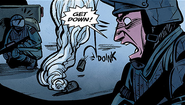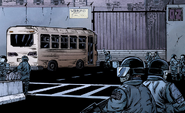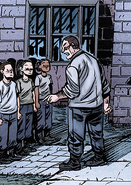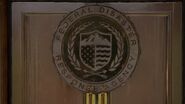| “ | Our strike against the FEDRA checkpoint worked. Killed at least three of those thugs...We'll kick those fascists out.
|
” |
The Federal Disaster Response Agency (FEDRA or F.E.D.R.A.), colloquially known as the military or army, is an antagonistic faction featured in The Last of Us and The Last of Us Part II.[6][7]
FEDRA was a government agency in the United States, tasked with responding to disasters and managing emergencies, now the sole military junta of the remaining US, enforcing law and order within the remaining quarantine zones. After the initial Cordyceps brain infection (CBI) outbreak, FEDRA seized control of the U.S. government and armed forces in order to set up the quarantine zones (QZs).[6] Becoming amalgamated with one another in the process, they imposed martial law and dissolved the other organs of state.[8] In the QZs, soldiers prevented citizens from leaving the city, subjected them to forced labor,[3] and when supplies were low, restricted basic food rations.[6][9] They often executed dissidents and criminals, or expelled them from the QZ. The Washington Liberation Front compared FEDRA soldiers to fascists.[5]
By 2033, FEDRA only exercises power over a small number of fortified cities, most notably Boston[6] as most have been either destroyed, abandoned, or taken over by rebels.[9][10][7] FEDRA is one of the last remnants of the pre-outbreak United States government, alongside the Department of Defense, and the Center for Disease Control (CDC).[11]
History[]
Early outbreak and taking control[]
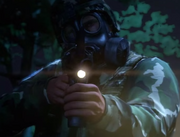
A FEDRA soldier during the initial outbreak.
Following the outbreak of Cordyceps brain infection (CBI) in September 2013, the Federal Disaster Response Agency, deployed across the country, working alongside with regular military forces and law enforcement, attempted to contain it. When Joel, Tommy, and Sarah attempted to escape the infection, they witnessed the military setting up roadblocks along the highways, which caused a large traffic jam. They also saw military helicopters flying over their heads. It is known that in Austin, Texas and other major cities, they were resorting to extreme measures to prevent the spread of the infection, such as summarily executing American citizens. An example of this was seen when a FEDRA soldier shot and killed Sarah.[12]
The pre-outbreak U.S. government was often at odds with FEDRA when it came to handling the infection. Shortly after a leaked report from the World Health Organization revealed that the latest Cordyceps vaccination tests had failed, a U.S. general affiliated with FEDRA announced on television that the government "bureaucrats" had been removed from power, and that they could finally take the necessary steps to "protect" the United States.[13] FEDRA went about this by declaring martial law and setting up quarantine zones in urban centers. The Department of Defense, as well some officials from the Department of Justice (such as Attorney General Arthur Munroe), worked closely with FEDRA during the initial outbreak.[14] However, most other branches of government were indefinitely suspended. A notable exception was the Center for Disease Control, which was retained to study Cordyceps.[15]
To contain the fungus, FEDRA had the military move all uninfected civilians into large quarantine zones (QZs) within major cities such as Boston, Pittsburgh and Seattle.[6][9][7] The number of entrants was limited - in Pittsburgh, civilians were murdered en-masse by FEDRA to prevent the QZ from overcrowding. FEDRA then had the U.S. Air Force carpet bomb the surrounding areas of some of the QZs, most notably the downtown area of Boston, to kill as many of the infected as possible, while also creating buffer zones.[16] To ensure the containment functioned smoothly, FEDRA developed their own Mycotoxin Containment Protocols, which had at least four levels of severity. At the most severe stage, Level 4, evacuees would be tested for infection, sanitized and their bags inspected before being split into different groups, with each group going to a different permanent quarantine zone.[17] Preventing the infection's spread was paramount, heightened after the World Health Organization reported that the CBI had killed or infected at least 60% of the nation's population by the early 2010s.[14]
FEDRA established their own central command headquarters, colloquially referred to as "CENTCOM", independent from the QZs.[1] To ensure they maintained connection with their units in the QZs, FEDRA created numerous outposts, using radios to communicate reports between QZs and their headquarters.[18][19] Lt. Carmelo Torres worked closely with FEDRA captain Paul Douglas, keeping in regular correspondence with him to coordinate FEDRA authority over the Seattle QZ.[1] FEDRA also worked with the CDC to produce various fliers and informative documents, ranging from informing civilians of wanted criminals,[20][21] to infographics about the stages of infected.[22][23][15]
FEDRA had the military fortify the zones with extreme levels of security. They placed soldiers and checkpoints at numerous points throughout the cities and created 30-foot-high concrete walls with guard towers and searchlights. The soldiers would often patrol the surrounding area to contain any citizens trying to escape or sneak into the zone and would pursue escapees several hundred meters from the zone's walls.[11] FEDRA also drafted civilians to perform work duties both inside and outside the quarantine zone, on a bi-yearly basis.[3] Civilians residing within quarantine zones could also join the military to bolster their numbers. Records of FEDRA members were subsequently kept in their headquarters.[24] FEDRA also maintained military boarding schools, where children were trained to become soldiers.[25]
FEDRA also worked in the early weeks of the outbreak to secure certain medical facilities. At the Seattle general hospital it is insinuated that the hospital contained critical research regarding the CBI outbreak, as FEDRA had sacrificed a significant amount of their soldiers to retrieve files contained in the overrun lower levels of the facility.[26][27] FEDRA also dispatched troops to deal with nests of infected in buildings surrounding the hospital. Avery's patrol (containing Seb, Victor, Irina and Mali) was sent to the Hotel BlacRay to clear the infected present by planting explosives.[28] However, their efforts failed, leading to the hotel surviving the blast but trapping the soldiers inside with the infected. Stalkers eventually killed the soldiers.[29][30]
As the years passed, the U.S. Attorney General, Arthur Munroe, made it clear that the military would be lowering their search radius to only ten miles from the QZs. This meant civilians in towns, universities, and the countryside were left to fend for themselves against the infected.[14] Several citizens expressed outrage at the military not maintaining efforts to find survivors, noting failure to do so doomed those people to become infected, starve to death or turn on one another to survive.[31][32][33]
By the mid-2010s, FEDRA had consolidated control of all major cities in the United States and converted them all into QZs. FEDRA initially allowed civilians living in the various QZs to write letters to inhabitants of other QZs that were delivered between them, even delivering them between zones over a period of two weeks.[34] However, FEDRA soon used the military's might to transform the zones into individual police states, exercising absolute power over the zones (including killing civilians).[10] Their growing tyranny prompted Marlene to create the Fireflies, a militia group dedicated to defeating FEDRA, restoring the pre-outbreak government and finding a cure for the disease.[13]
Resisting dissident groups and losing power[]
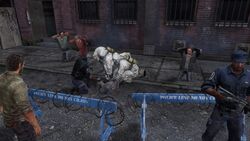
FEDRA soldiers euthanize a woman that had been scanned positive for infection.
During FEDRA's control over the quarantine zones, anger grew towards the military and their rule over America's people living in the cities. The first known dissident faction was the Fireflies, a group founded shortly after Los Angeles was placed under martial law in the 2010s. The group called for the return of all branches of government and staged several attacks against the military. Anti-FEDRA sentiments began to appear throughout contiguous America after the military executed at least six Firefly members.[8] Alongside this, a conspiracy theory grew among people in the quarantine zones that FEDRA were hoarding rations for themselves rather than feeding the civilians. In time, large numbers of civilians in numerous quarantine zones came to believe in the Fireflies' idea of living under their own rule rather than that of the military's.[6][9][7]
By the 2020s, numerous QZs fell into civil war between the citizens and FEDRA's soldiers, ranging from protests and riots in Pittsburgh to outright warfare in Seattle.[9][7] The Fireflies assisted in these uprisings, especially in Pittsburgh. The military fought hard to keep control of the zone, deciding to publicly execute three people they branded as traitors to the peace. This action only furthered Firefly support, with an alliance forming between them and the city's residents.[21] Large-scale fighting broke out over the next fourteen months,[35][36] ending with Captain Mastros calling for his soldiers to abandon the zone,[37] and the rebels lynching any soldiers they captured.[38] They even captured and burned Mastros and his squad to death.[39] The rioting citizens did not want to be controlled by FEDRA, nor take orders from the Fireflies. Thus, it wasn't long before they killed the Firefly agitators as well.[40] They later found and killed the soldiers hiding out in the city's hotel and secured a working Humvee from a fleeing military garrison, meaning the city was now completely under their control.[41]
Meanwhile in Seattle, FEDRA rule faced challenge from a terrorist group known as the Washington Liberation Front, a group of dissident residents enraged by the expulsions, food shortages, and executions the military conducted under Lt. Torres and Sgt. Ward's rule.[42] While FEDRA had worked well in collaborating with civilians in the zone, even receiving help from Boris Legasov in combating the infected around the Hillcrest community,[43] the WLF represented the wing of civilians against military rule.[44][45][46] The WLF's leaders Emma and Jason Patterson conducted an anti-FEDRA campaign, distributing anti-FEDRA propaganda, stealing the military's supplies and inciting sedition among the Seattle residents.[47][48]
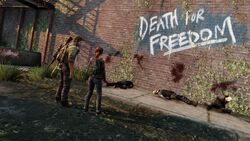
FEDRA soldiers that were executed by rebels in Pittsburgh.
Eventually, the military eliminated the Pattersons, along with most of the other WLF leaders, leaving Isaac Dixon as the last remaining original instigator of the rebellion.[47] In retaliation, Isaac killed three soldiers to avenge the Pattersons. While several citizens were morally against Isaac's actions, the remaining WLF members voted him as their new leader. Over the coming weeks, the WLF attacked military checkpoints, assaulted convoys, and committed open armed conflict against the military.[5]
Some Seattle residents were known to break away from the WLF and collaborate with FEDRA for their own benefits and privileges. In one such incident, Jiao tipped off an anti-WLF action that Mei and Bo were planning with an illegal shipment of goods.[49] As such, the WLF instituted a zero-tolerance policy towards any WLF members who collaborated with FEDRA in any way.[50]
To counter the WLF's growing aggression, Torres ordered the soldiers open fire on any and all WLF protests, including peaceful ones. The order led to the Thursday Market massacre, an event that saw the military's brutal response to the WLF march cause a surge in WLF support and membership among the Seattle residents. The action was particularly controversial as the protesters were campaigning for food for their families and ended the military's propaganda campaign to frame the WLF as a terrorist group filled with murderers; the WLF now became known as the citizens' own freedom fighters.[51] The increased membership led to further success for the WLF, with even FEDRA soldiers defecting to join the militia group.[5]
In time, the military gave up on their campaign to defeat the WLF, with Torres ordering Ward to evacuate the military personal from the city along with rabbi Zivah Saunders and their family.[52] Torres penned a note to Paul Douglas at FEDRA Headquarters conceding that the zone was lost.[1] The WLF did not allow the soldiers to leave peacefully though, instead using a tip from a Seattle resident to ambush the soldiers' convoy on the highway, where they slaughtered them in open combat. Torres and Ward's squad managed to escape the battle, but the WLF chased them to the courthouse, where they finished the fight in a final skirmish, successfully killing the military's leadership and officially ending their reign over the city.[53] Within a few months, the WLF successfully captured all of FEDRA's military checkpoints in the city. With that, the WLF had successfully won the war against FEDRA and now controlled the QZ.[18][51]
However, some FEDRA personnel fled into the city's suburbs. Unwilling to let them reintegrate into the city's community, the WLF hunted them down to clear the city of the military completely.[24][54][51] They also killed Boris's daughter Sofia Legasov in Hillcrest.[46][45]
A portion of the military force assigned to Seattle managed to pull out successfully. Notably, Perez, Green, Adams and an unnamed soldier succeeded in escaping the WLF's slaughter and hid out at a radio outpost in the city for several days.[19][18]
The Fireflies continued their efforts to disrupt FEDRA's rule throughout the country as well. In Denver, Tommy Miller and Eugene Linden's Firefly cell waged war against the military in the city, regularly bombing checkpoints. The pair even tortured a FEDRA general while stationed there.[2] The Fireflies successfully defeated the FEDRA soldiers in Salt Lake City, converting the local hospital into their primary base by the early 2030s.[55]
Late outbreak and remnants of control[]
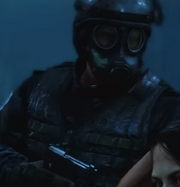
A FEDRA soldier 20 years into the outbreak.
By 2033, according to Joel, FEDRA had lost control over many quarantine zones, and hunter rule was the norm in those areas.[9] Hartford is falling apart, leaving Boston as the only known fully operational QZ. Many of the residents circumvented the military's strict rule through their smuggling trade, from land and sea. At least an entire battalion was stationed here,[56] under the command of a general,[3] and the majority of soldiers still possessed high-grade weapons like assault rifles and .50 caliber MG-mounted Humvees.[6] Despite this, many soldiers only carry a sidearm rather than a primary weapon, and some weapons that would have been antiquated in the U.S. military by 2013, such as revolvers, have been brought back into service. The military also did not control the mall within the zone and were running low on supplies by July that year.[57] Soldiers talked about the prospect of riots breaking out. Still, they had been largely successful during their summertime crackdown on the Firefly presence in the city.
Much like the other QZs, Boston was plagued with starving citizens, rigid work duties and strict curfews on all residents.[58] The military used barriers to prevent anyone from leaving without permission or entering certain areas in the city. There were regular checkpoints throughout these zones where civilians were required to present identification papers, such as a quarantine passport. There were also random infection checks, with the military killing infected people immediately via lethal injection or outright shooting them. Like in Seattle and Pittsburgh, people here believed the soldiers were hoarding food for themselves.[59] Citizens also had to assist the military in work duties, such as fortifying the wall.[3] While doing so, they had to wear yellow suits crafted in a similar fashion to the military's uniforms, except these clearly denoted their ranks as civilian workers rather than soldiers. In contrast, the soldier's blue uniforms had the word "ARMY" on their chest patches, as well as on FEDRA-owned doors and devices.[6] Citizens who refused had their ration cards revoked and were placed in solitary confinement, punishments which the people heavily disparaged.[3]
Regardless, many outside the Boston QZ believed living within the walls under military rule was a safer life than those living outside the zone.[60] Further, complaints against FEDRA were low enough that the soldiers did not bother to arrest people for petty sedition, despite it being a crime according to FEDRA in former QZs. Indeed, the thriving smuggling market of food, guns and drugs appeared to placate Boston's residents enough to not rebel openly to FEDRA rule. The only openly active resistance to FEDRA rule came from Marlene and the Fireflies living in the zone, who bombed checkpoints daily and got into numerous skirmishes with the military throughout the city. However, by the summer of 2033, the military had clamped down on the Firefly insurgents, leading Marlene to order her troops to withdraw from the city, meaning the military's rule over Boston uniquely survived militia rebellion for control. However, the smugglers within the city learned that supplies were running out, meaning the chance of civilians rebelling against the military's rule within the zone was increasing.[6]
The military did recently control Hartford but that too fell to rule by hunters because of food shortages. Some citizens from Hartford were trying to sneak into the Boston QZ. Sergeant Winston Asher encountered them and killed the ones that were infected. He wrote to his superior Major Banks regarding the incident, asking for more patrols, but did not expect the officer to reply as he felt Banks was incompetent and the military were running low on supplies at the time.[57]
Events of American Dreams[]
FEDRA has little tolerance for Fireflies and their sympathizers. They cause "disappearances" and summarily execute civilians suspected of being Fireflies. According to Ellie, they even train teenagers at their military preparatory schools on how to kill Fireflies.[61] The military, in their mission to eliminate the Fireflies, engaged them in key points throughout Boston. At one point, they successfully pinned them down in the streets, nearly succeeding in defeating all of Marlene's squad. However, Riley Abel, situated on a roof above the firefight, intervened by tossing smoke grenades at them, disrupting their line of fire, enabling the Fireflies to escape. The soldiers attempted to shoot Riley, but she escaped.[25]
Events of The Last of Us[]
When Joel and Tess are following Marlene to where Ellie is hiding, they cross through FEDRA soldiers fighting and capturing Firefly militia. Marlene comments that she and her fellow Fireflies intended to leave peacefully, but the military attacked their various hideouts. She believes the military's recent attacks against her group are intended to distract the Boston residents from the growing food shortage FEDRA are suffering from, deducing the military intend for her to become a scapegoat for the city's problems.[6]
By night time, when Joel and Tess are smuggling Ellie outside of Boston, they are surprised by two soldiers patrolling the outskirts who subdue Joel and order Tess and Ellie to put their hands on the heads and kneel down. When scanned for infection, Ellie stabs the soldier in the leg, causing the soldier to knock her down. Joel tackles him, wrestles his gun away, and kills him; Tess shoots the other dead before making their escape. Humvees and infantry pour into the area to search for them but eventually retreat when they lose track of the group. Such implies any "stragglers" found outside the Boston wall are sent back to the QZ and charged, as Joel and Tess were going to be escorted back before Ellie was scanned.[11]
While crossing through a building, the trio encounters dead soldiers and several who had turned into runners, who had left the zone to search even the severely damaged downtown for supplies despite the high risk. This implies the military is becoming increasingly desperate to find supplies to keep the QZ from falling apart.[11] They learn the soldiers (officer Waters, Private Shah, Private Coolidge, and Private Atwater) had encountered stalkers but died while awaiting reinforcements.[62]
By morning, the military caught up to the trio at the Capitol building, having earlier killed the Fireflies that they were supposed to rendezvous with. Tess killed two soldiers before dying, while Joel and Ellie evaded the others via fighting past various squads of soldiers before making it to the subway line, narrowly avoiding being shot at by a Humvee.[11]
They are shown to conduct vehicle patrols that go outside the walls to search for anything worth taking, going as far as Lincoln. One such patrol was overrun by infected and crashed into Lincoln High School. Bill wanted to steal the battery from a truck, as the military are the only ones who make new batteries anymore.[63] This indicates that they have at least some industrial capacity; given how it seems standard policy for smugglers to be captured, if possible, it is possible the military uses prisoners as labor to allow troops to focus on their duties.
Events of Left Behind[]
FEDRA's entire 4th Infantry Division was stationed in the Denver QZ.[64] Members from this section followed an "infection protocol"; with no cure discovered, all personnel that become infected are to be executed immediately. This includes civilians. Chief Warrant Officer Larry Caulfield was executed by Captain Regan Francis after the former was bitten when their helicopter crashed at the Colorado Mountain Plaza. The pilot, Sean Brendon, was also bitten but died upon impact.[64] Regan later showed regret, writing that she "shot him like a dog" while he begged and tried to tell her that he still had time left.[65] However, when Private Ellis got bit, Regan immediately amputated his right arm, thinking it would prevent the fungus from infecting him. With no recorded precedent of a human ever surviving a bite via amputation, the two wondered whether Regan's actions were right or not. Regan initially thought of abandoning Ellis but later decided to stay with him.[66]
Ellis later killed her out of fear that he would be killed when she reached for her gun and died of his injuries in an air duct after escaping from some infected.[67] Ellie can find recordings of their predicament left all around the shopping mall.[68][69]
Events of Part II[]
Sometime before 2034, according to Dina, some disgruntled FEDRA members broke off from the organization to form a group in New Mexico called the Ravens, who were known for running protection rackets and taking multiple wives.[7]
Equipment[]
Hand-held equipment[]
FEDRA soldiers use assault rifles with mounted flashlights and wear gas masks and body armor, but clearly do not have enough to spare for every soldier to use. Thus, many soldiers go without adequate protection, and/or are forced to use 9mm pistols as their primary weapons.[6] Some soldiers even use revolvers.[11] They also use smoke grenades when facing Firefly militia.[25]
Their uniforms have changed completely; they now wear blue uniforms (possibly the Operational Dress Uniform). Their old uniforms were likely replaced due to deterioration over the course of 20 years, and the military's limited industrial capacity made it easier for them to produce plain blue uniforms rather than camouflage; possibly since the latter would need to be produced in greater quantities, due to requiring forest, urban, winterized versions and so forth. In addition to their standard uniforms, some soldiers wear ballistic vests and police-style riot helmets. These riot helmets are likely used to protect the face from attacks by hostile survivors and infected, although they are shown to function in the capacity of a combat helmet as well, being capable of saving the wearer from a headshot with a firearm.[6] Handheld scanners have been developed, which allow troops to easily test individuals for infection. They are very accurate, one correctly identifying Ellie as infected within seconds.[11]
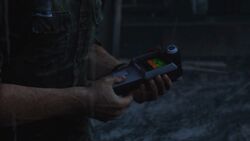
A standard military scanner. It scans for traces of infection.
During the initial outbreak, a soldier is seen wearing a uniform with woodland camouflage commonly seen as part of a MOPP Suit worn by soldiers during chemical warfare. Coupled with the gas mask, this implies that the government believed (not incorrectly) that the disease could have been airborne or spread by physical contact, explaining the high amounts of protection.[12]
Types of soldiers[]
In The Last of Us, there are three types of FEDRA soldiers that are encountered. Some soldiers are armored and often wield assault rifles more than pistols. They patrol on top of buildings and guard checkpoints, as well as being the primary troops who conduct operations outside the safety of the wall, such as patrols or supply runs. These appear to be the "regulars" of the military.[6]
Other, non-armored troops are seen to only have blue uniforms and field caps, carrying pistols more than assault rifles. These lightly-equipped soldiers are mostly encountered inside of the Boston wall, so it can be assumed that they are recruits or some form of city defense force. Although their jobs appear to be centered more on policing than combat, they are encountered in the same squads as heavier troops in some situations.[11]
Another type of soldier is also seen just once, who cannot be fought. They carry assault rifles and wear HAZMAT suits, gas masks, and oxygen tanks. They deal with environments that are contaminated by spores, such as the condemned apartment building where civilians are hiding during the beginning of the game. Their equipment appears to offer enhanced protection from spores over just having a respirator; their oxygen tanks suggest that they can operate in spore-contaminated zones for longer periods of time than other troops.[6]
There were also medical squads within the military, seen in Left Behind. For instance, a squad of soldiers from the Denver QZ wore green uniforms similar to the non-armored soldiers in Boston, with the notable distinction of having a Red Cross arm band on their right arms. They lacked bulletproof vests but typically carried surgical supplies with them.[70]
Vehicles[]
FEDRA's soldiers still use M939s along with Humvees and mounted .50 caliber machine guns and loudspeakers. A wrecked M35 truck was also seen in Lincoln, appearing to be a short-body variant. Several long-abandoned ones were seen scattered across the country, and the Fireflies once used of some at the University of Eastern Colorado.[71] Two burned-out M2 Bradley IFVs were seen in Pittsburgh. Another long-abandoned one was seen in the FEDRA camp in Salt Lake City.[10] Bill's dialogue suggests that they scavenge fuel from abandoned vehicles.
It is interesting to note that no operational aircraft are seen post-outbreak, although Tess explains after leaving the Boston quarantine zone that the military carpet-bombed the city around the QZ to create a buffer zone and kill as many of the infected as possible.[11] A crashed military helicopter, possibly a UH-60 Blackhawk, appeared in the Colorado Mountain Plaza, indicating that there is still a handful in use.[70]
Strength[]
FEDRA's military units are the strongest faction the player encounters, rivaled only by elite members of the Fireflies, as they still have access to assault rifles, body armor, and Humvees despite being fought at such an early stage. The military's strength is so strong that the Fireflies actions to defeat them have proved mostly futile, with the military resisting many terrorist attacks on checkpoints and rioting in various cities throughout post-apocalyptic America.[6]
However, the hunters and Fireflies combined forces were enough to defeat the military in cities like Pittsburgh, greater numbers contesting the military's training and resources.[38][36][37] The Washington Liberation Front was also able to defeat the military garrison stationed in Seattle, even after suffering heavy casualties due to a string of successful military counter-insurgency operations.[1] Regardless, lone survivors typically struggle.[11]
The player is unable to combat them when first encountering them in Boston. Attempting to attack or bump into the soldiers there causes them to shove the player back and give a warning. Bumping into the same guard again will make them knock the player down and fire a shot into their head instantly killing the player.[6] Later, when in the outskirts, engaging them in a firefight is ill-advised because the player lacks powerful guns and ammunition. As such, stealth killing or simply sneaking past them is preferable. However, if faced in smaller or weaker numbers (like in the Capitol building or the abandoned subway station underneath it) the player could face them head-on then since they only use pistols rather than assault rifles.[11]
Of the groups shown to face infected, the military has actually lost a lot of their soldiers despite being the best-trained and equipped faction left. The squad that encountered infected in downtown Boston were overrun, many becoming infected or being killed.[62] Avery's squad in Seattle, that encountered a group of stalkers, met a similar fate.[28][30] A heavily armed squad sent to retrieve data research about the infected from the Seattle hospital were also all slaughtered by the infected living there.[26] A mounted patrol was also overrun, crashing into Lincoln high school.[63] Even a four-man unit lost two men when facing just one runner.[64] However, there was one account where a soldier defeated three runners by himself, without being bitten.[57]
Known members[]
- Adams
- Private Atwater (deceased)
- Avery (deceased)
- Major Banks
- Benny (deceased)
- Lieutenant Carmelo Torres (deceased)
- Private Coolidge (deceased)
- Corporal "Dickhead"[58]
- Ellie Williams (preparatory school; formerly)
- Private Eugene Ellis (deceased)
- Green
- Irina (deceased)
- Jeremy[36]
- Chief Warrant Officer Larry Caulfield (deceased)
- Colonel Mackenzie
- Liz (preparatory school)
- Mali (deceased)
- Captain Mastros (deceased)
- Private Miller (deceased)
- Pam[36] (deceased)
- Captain Paul Douglas
- Perez
- Princess
- Ramirez (deceased)
- Captain Regan Francis (deceased)
- Riley Abel (preparatory school; formerly; deceased)
- Warrant Officer Sean Brendon (deceased)
- Seb (deceased)
- Private Shah (deceased)
- Victor (deceased)
- Sergeant Ward (deceased)
- Waters (deceased)
- Sergeant Winston Asher (deceased)
Collaborators[]
Behind the scenes[]
- The name FEDRA resembles the real world Federal Emergency Management Agency (FEMA).
- During development, Naughty Dog first called FEDRA the "Military Safe Force" (MSF) and later "Federal Disaster Response Administration". Some signs for these mid-development names can still be found in the original game and on some maps in Factions MP.
- In the original game, FEDRA and the U.S. military appeared to be two distinct groups, judging from how dialogue specifically named them as separate entities. Further to this, the unarmored soldiers had (in small text) 'ARMY' on their shirts. However, in the updated models in The Last of Us Part I, all types of soldiers and functioning military vehicles now sport FEDRA markings. Additionally, the military barriers seen on several doors inside QZ apartments had the text on them changed from "U.S. ARMY" to "FEDRA". Combined with this and FEDRA's military detachment present in Part II and numerous collectibles referring to FEDRA and the military as the same group, the consensus is that the Naughty Dog developers retconned the distinction between FEDRA and the military.
- FEDRA recruits females but they are not encountered during in-game combat. Instead, they appear in cinematics and as NPCs while moving around the checkpoint in Boston. Regardless female runners outfitted within military uniforms and gear can be fought with Boston's downtown area.[6] Ironically though, when using the photo mode on the Remastered edition, all FEDRA NPCs register as friendlies until the player faces them as the Capitol building.[11]
- The crashed helicopter in Left Behind bears an incorrect paint scheme and markings. Blackhawks that are used for medical evacuation would be painted an overall dark grayish-green, with small Red Cross markings on the nose and side doors.[70] In Part II, an M1 Abrams tank that can be found in Seattle while exploring the downtown area with Dina bears markings "USMC 198533", identifying that it had previously belonged to the United States Marine Corps.[7]
Gallery[]
The Last of Us[]
The Last of Us Part I[]
Left Behind[]
American Dreams[]
The Last of Us Part II[]
References[]
- ↑ 1.0 1.1 1.2 1.3 1.4 Lt. Torres' final memorandum
- ↑ 2.0 2.1 "Jackson"
- ↑ 3.0 3.1 3.2 3.3 3.4 3.5 Drafting notice
- ↑ File:WLF Rules Must Be Followed.png
- ↑ 5.0 5.1 5.2 5.3 WLF recruiter journal
- ↑ 6.00 6.01 6.02 6.03 6.04 6.05 6.06 6.07 6.08 6.09 6.10 6.11 6.12 6.13 6.14 6.15 6.16 "The Quarantine Zone"
- ↑ 7.0 7.1 7.2 7.3 7.4 7.5 7.6 "Seattle Day 1"
- ↑ 8.0 8.1 Twenty Years Later
- ↑ 9.0 9.1 9.2 9.3 9.4 9.5 "Pittsburgh"
- ↑ 10.0 10.1 10.2 "Bus Depot"
- ↑ 11.00 11.01 11.02 11.03 11.04 11.05 11.06 11.07 11.08 11.09 11.10 11.11 "The Outskirts"
- ↑ 12.0 12.1 "Hometown"
- ↑ 13.0 13.1 Twenty Years Later
- ↑ 14.0 14.1 14.2 Newspaper clipping
- ↑ 15.0 15.1 Medical pamphlet
- ↑ Evacuation leaflet
- ↑ Boy's diary
- ↑ 18.0 18.1 18.2 Lone FEDRA soldier journal 1
- ↑ 19.0 19.1 Lone FEDRA soldier journal 2
- ↑ Wanted poster
- ↑ 21.0 21.1 Traitors flyer
- ↑ Military pamphlet
- ↑ Infected infographic
- ↑ 24.0 24.1 Yolanda's note
- ↑ 25.0 25.1 25.2 The Last of Us: American Dreams
- ↑ 26.0 26.1 Soldier's letter
- ↑ Chapel note
- ↑ 28.0 28.1 FEDRA orders
- ↑ "Seattle Day 3"
- ↑ 30.0 30.1 FEDRA final note
- ↑ "The Suburbs"
- ↑ Looting note
- ↑ Neighbor exchange
- ↑ Note to wife
- ↑ Note from mom
- ↑ 36.0 36.1 36.2 36.3 Lost Hill note
- ↑ 37.0 37.1 Abandon zone note
- ↑ 38.0 38.1 Final attack note
- ↑ Mob attack note
- ↑ Fireflies note
- ↑ Truck note
- ↑ FEDRA census document
- ↑ Boris' daughter's drawing
- ↑ Turn in Boris note
- ↑ 45.0 45.1 Condolence note
- ↑ 46.0 46.1 Boris' confession
- ↑ 47.0 47.1 List of known WLF agitators
- ↑ Join WLF note (Downtown)
- ↑ 49.0 49.1 Jasmine Bakery safe
- ↑ "Seattle Day 2"
- ↑ 51.0 51.1 51.2 Plea to a friend letter
- ↑ Rabbi Saunders' letter
- ↑ Note to informant
- ↑ Rebecca's tip off
- ↑ "The Firefly Lab"
- ↑ Marlene's journal
- ↑ 57.0 57.1 57.2 Warning note
- ↑ 58.0 58.1 "Fun and Games"
- ↑ "Mallrats"
- ↑ Note to brother
- ↑ "Back in a Flash"
- ↑ 62.0 62.1 Field ops log
- ↑ 63.0 63.1 "Bill's Town"
- ↑ 64.0 64.1 64.2 Salon note
- ↑ Generator note
- ↑ Atrium recorder
- ↑ Duct recorder
- ↑ Atrium note
- ↑ Crew photo
- ↑ 70.0 70.1 70.2 "The Enemy of My Enemy"
- ↑ "The University"

